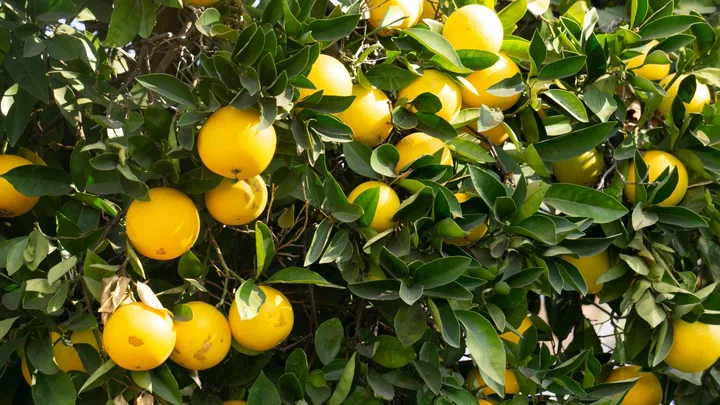It’s important to prune your lemon tree at the right time and in the right way. Pruning means healthier trees and healthier fruit, ensuring the tree is sturdy and provides a plentiful harvest.
If you’re not sure exactly how to prune your lemon tree, here are the tips you need for a sweet harvest every season.
Should lemon trees be pruned?
Absolutely! In fact, most lemon trees benefit from regular pruning, especially in the first two years of their life. Applying controlled stress to the plant signals new growth, telling it to focus more of its energy on developing the remaining buds. This prepares it to produce bigger and better lemons as it ages.
If your tree has been left to its own devices, you may notice a lot of volume and foliage going in different directions. After pruning, the leaves and branches will receive more air and sunlight, resulting in balanced fruit across the tree.
If you have a young tree, trimming off lower growths will keep the plant manageable, with minimum effort and maximum results down the line.
Can I cut the top off my lemon tree?
You can remove the top shoots and branches from a young lemon tree to help shape it and make it easier to maintain. This is commonly known as topping (more on that later).
When is the best time to prune a lemon tree?
Depending on the climate, it’s best to prune a lemon tree in spring or autumn.
- Baby lemon trees aren’t encouraged to bear fruit until they’re older.
- Young lemon trees are pruned as often as needed to shape their structural framework.
- For mature lemon trees, the best time to prune is after every harvest, once or twice a year.

Types of lemon trees
The three most commonly found lemon trees in New Zealand are the Eureka, Meyer and Lemonade. The Eureka is the most widely grown worldwide, with a bitter flavour but high juice and acid content. The Meyer is a more cold-hardy variety, juicy and sweeter than the Eureka. The Lemonade is a hybrid between a lemon and a mandarin, and as the name suggests, perfect for making lemonade.
The tools you need to prune a lemon tree
Its always important to have the right gear. This includes a trusty pair of pruning shears or a small hand-held saw – depending on the size and age of your tree. Be sure to disinfect your tools and always wear protective gloves when working.
For preventative measures, pick up some organic herbicide to apply after pruning. All citrus trees are notorious for weevils, snails and gall-wasp infestations that can cause diseases and ruin your harvest.
5 steps to prune a lemon tree
If you see weak branches, small growths near the base of the tree trunk, or deadwood, it’s time to get out the shears. Just take note to not prune during winter or summer as the branches could be damaged by frost or sunburn.
Step 1: Planning
Before getting started, you need to make a plan and prepare your equipment. Take a good look at your lemon tree, searching for any unhealthy or stray branches. Gather your gardening gloves and clean pruning shears.
Step 2: Pruning
Start by removing deadwood from the branches of the tree. Take out any thin branches to give the bigger ones a boost. Any cuts should be at a 45-degree angle, making sure not to damage the main stalk.
Remove ‘suckers’, water spouts and basal shoots are just as important. These small, leafy growths come from the base, near the roots, and may indicate that the soil bed is too shallow. Prune these so they don’t suck the nutrients from the lemon tree.
Step 3: Skirting
This term refers to getting rid of the bottom growth to prioritise fruiting at the top of the canopy. As wasteful as it may seem, you may have to get rid of any underdeveloped fruit if you want the top batch of buds and lemons to be healthier.
Skirting also helps prevent the leaves from touching the soil or getting contaminated by fertilisers or herbicides. Having your bottom branches a few feet away from the ground can help keep pests from climbing the tree and spreading diseases.
Step 4: Topping
If you want to shape your lemon tree, you can give it a bit of a chop at the top. But don’t overdo it, as this is more of an aesthetic concern than a practical one. Make sure that the ratio of branches matches the density of its roots, so try to give it a more rounded, symmetrical shape.
Step 5: Stopping
Be careful not to overprune. Part of the pruning process is knowing when to stop. It’s perfectly fine to chop off one-third of the tree, but not any more than that. If you prune too much, you could overstimulate and stress the plant.
How to cut a lemon off a lemon tree
Hand-picking is typically the easiest way to get lemons off a tree. Just hold the lemon in your hand and gently tilt it away from the stem, twist it lightly and allow it to snap off. Make sure the whole stem leaves the tree.
Another option is to use clippers or secateurs to make a clean cut above the fruit’s stem. Make sure the rest of the branch is healthy, then enjoy the fruits of your labour.
Growing lemon trees is fun and maintaining them is worth all the extra effort. Whether indoors or outdoors, they make a delightful addition to your home and garden. Just remember that regular pruning is the key to a happy tree. With these tips we’ve given you, you’re sure to get the fruitful harvest you deserve.
Related articles:
- 8 fast-growing climbing plants anyone can grow
- 10 gardening gifts for loved ones with a green thumb
- The best garden sheds on the market









